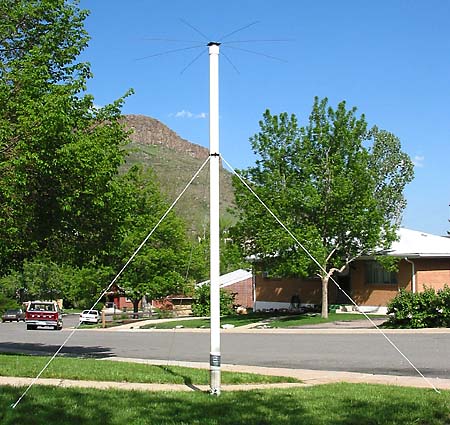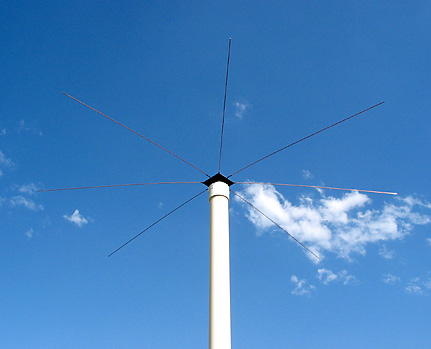

On May 16, 2003 I got the new Ionic Liquid Antenna set up for some preliminary testing. It is a 10-foot length of 3" diameter PVC tubing. At the base is a home brew "L" tuner. A probe at the bottom of the tube, consisting of a 3" diameter copper plate, transfers the RF energy from the coax into the solution. At the top is a capacitance hat made from brazing rod with a floating plate of copper to transfer the RF energy from the liquid conductor back through metal. Inside the 3" PVC pipe I placed a capped, empty 1.25" PVC pipe so that the water would form a hollow 'tube' of liquid. The idea was to test "skin effect" in an ionic solution. A side-by-side comparison would have to be done, but has not yet been performed.
The antenna is filled with almost 3 gallons of 23% calcium chloride solution. I have made the switch from sodium chloride (table salt) to calcium chloride. One advantage is the -25 degree F. freezing point vs. the -4 degree F. of saltwater. I found the calcium chloride sold as Prestone "Driveway Heat" and mixed the pellets at 2.5 pounds-per-gallon of water.
Once I had it tuned up on 40 meters, I had a 1.1:1 SWR mid-band and no more than 1.2:1 between 7.000 and 7.300 MHz using only two 18-foot copper braid for radials. This was with the tuner tap set at 6 turns out of the total 22 turns of the coil. Obviously, this indicates a low-Q antenna. The highest frequency I can tune it with the L-tuner (below 2:1 SWR) is 12.5 MHz, but that was using a single tent stake as ground, and using none of the coil and none of the top hat radials inserted. The lowest tunable frequency using all of the base coil without the top-hat radials was 4.010 MHz. When I added the top hat, I was able to tune to 3.500MHz! I eventually will try a chicken wire screen as ground.
But how well did it work? Well, on 40 meters with an S-8 noise level early in the evening with 5 watts from an FT-817 I worked Provo, UT with Q5 copy both ways. Then later I switched to the IC-706 and ran anywhere from 35-100 watts to test the ability of the antenna to take high power. I received a 59 report from Georgia and California, and a 57 from Alabama. And this was with only two 18' radials! Why 18 feet? They are the wires I have use with my 8 foot rowboat as a counterpoise when I am marine mobile with 1/4-wave antennas, and they were readily available.
Another time, On October 27, 2003, I had it set up in the front yard without the top hat and only filled about 3/4 full. Again running only five watts but this time on 17 meters, I worked Steve, WB2WIK, in Los Angeles and a friend of his Dave, WA6DKN, who was in San Diego at the time. They were not able to hear each other, so I passed messages back-and-forth between them.
The following three pages show more details on the design and construction of this antenna.
...